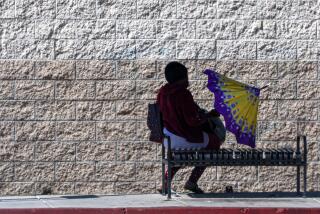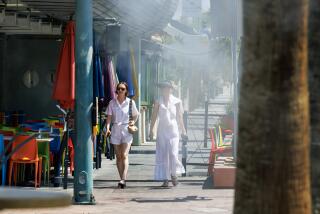August Forecast : Peachy Beach Weather May Stick Around
- Share via
July was hot, but not uniformly so. The first week and a half had the kind of weather in which you go to the beach because you have to to escape the heat. The rest of the month was the kind in which you go to the beach because you want to.
August looks, for the most part, as if it is going to be “want to” weather rather than “have to.” The National Weather Service said there is a 55% chance that August will be hotter than the normal average of 84, but probably not too much hotter.
Record high temperatures were established July 1, 2, 3 and 9. The high of 107 on July 1 was just two degrees below the historical high for July established in 1891. Record high minimum temperatures were also established the first seven nights of the month.
Temperatures were closer to normal the rest of the month, but there was only one day when the high was below normal--July 23, when it only reached 83.
Humidity was also above normal at the beginning of July, but only slightly. Most people assumed that it was higher than it was, according to Robert Webster, a weather service specialist. “At those higher temperatures, you just feel it more,” he said.
For the month, there were 22 days on which a first-stage ozone episode, indicating unhealthful air for everyone, was declared. A second-stage episode, indicating hazardous air, was declared on one of those days. Both figures are about normal for July.
Cloud coverage figures for July will not be available from the weather service until next week. In general, however, the beginning of the month was distinguished by clear blue skies, the end by low-lying early morning clouds that burned away by afternoon.
The outlook for August is more of the same. “Weather patterns around the world normally change more slowly in summer,” said Arthur Thomas of the National Weather Service’s climate analysis branch in Suitland, Md., “and right now they are changing even slower than normal.”
The record temperatures in Southern California during the first week of July were the product of a large mass of dense air centered over southern Utah and northern Arizona.
“That high-pressure mass acted like a roadblock to hot, dry air from the Mexican desert,” Thomas said. That mass forced “the air to flow around it much like water flows around an island in a river,” he added.
Part of the hot air flowed north along the Pacific coast, bringing unusually warm days and nights to regions as far north as Washington. Part of the desert air also flowed around the eastern side of the high-pressure area, bringing high temperatures and droughts to the northern plains states.
‘Furnace’ Heats the Air
That dense mass of air eventually moved out of the area and was quickly replaced with what is known as a thermal low, a common occurrence during the summer months. “The terrain and the soil and the direct sunlight in that region combine to make a furnace that heats the air and makes it less dense than normal,” he said.
That thermal low-pressure area has the same blocking effect on the Mexican air as the high-pressure area before it did. The thermal low is centered slightly farther east, however. The hot air flowing past is thus forced through the interior of California before continuing north along the coast. Oregon and Washington stayed hot, but Los Angeles was spared.
The heat has moved inland. Last week, Blythe, Daggett, Red Bluff and nearby areas had average daily temperatures above 100, well above their normal averages.
More to Read
Sign up for Essential California
The most important California stories and recommendations in your inbox every morning.
You may occasionally receive promotional content from the Los Angeles Times.










